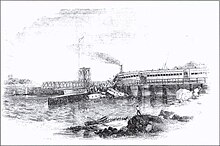Norwalk Railway Accident
When Norwalk rail accident crashed on 6. May 1853 a train due to an open vessel traffic swing bridge at the railway station of Norwalk in Norwalk River . 48 people died, 8 were missing, 30 injured. The accident was the first major one in the United States to involve a bridge .
Technical framework
The railway of New York and New Haven Railroad from New York to Boston crosses in Norwalk the Norwalk River with a swing bridge - now the only remaining on the track. The approach to the bridge from New York was in a strongly curved curve. The navigability of the bridge was indicated to the locomotive staff via a signal .
course
The express train left New York at 8 a.m. with 200 passengers heading for Boston and was approaching Norwalk station at around 75 km / h. It consisted of two baggage cars and 5 passenger coaches . The engine driver only drove the route for the third time. As he approached the bridge, he neglected to pay attention to the signal that said "stop". It was only about 130 m before the bridge that he noticed that it was open to shipping and closed to rail traffic. The bridge had been opened for the passage of the steamship Pacific , which had just passed. The engine driver initiated an emergency brake , let the machine work backwards and then - like the stoker - jumped off. Neither were seriously injured. The braking was not enough to bring the train to a standstill.
The locomotive shot over the approximately 20 meter wide bridge opening, slammed 3 meters below track level against the opposite bridge pillar and then sank into the approximately 4 meter deep water. The following two baggage cars came to rest on the locomotive. The following passenger car was smashed against the baggage car and the second passenger car pushed itself onto the wreckage of the first, so that the first passenger car was immediately pushed under water, with many travelers drowning, probably including the 8 missing people, whose bodies then washed into the nearby Atlantic were. The third passenger coach broke: the front part hung over the edge of the bridge, the rear part remained in the track bed .
The number of victims would probably have been higher had it not been for immediate medical care: In the last carriages of the train were many doctors who were returning from the sixth annual convention of the American Medical Association in New York. However, seven of them were also killed.
consequences
The subsequent criminal proceedings against the engine driver awarded him the main culprit. His behavior was classified as grossly negligent . As a consequence of the accident, the state of Connecticut passed a law according to which all trains had to stop in front of a railway bridge that could be opened, the locomotive crew had to check whether they could be crossed and only then were allowed to continue the journey.
useful information
Among the survivors was Johann Gerhard Oncken , the founder of the German Baptist congregations , who was on a trip through the USA.
See also
literature
Web links
- Article about the accident
- The Norwalk accident
- Eyewitness report by passenger Dr. Gurdon Wadsworth Russell
Individual evidence
- ↑ The Pacific had an accident almost three years later, in January 1856, on the way from Liverpool to New York itself.
- ^ Josef Lehmann: History of the German Baptists , 2nd volume, Cassel 1900, p. 157ff.
Coordinates: 41 ° 6 ′ 1.6 ″ N , 73 ° 24 ′ 54.4 ″ W.

